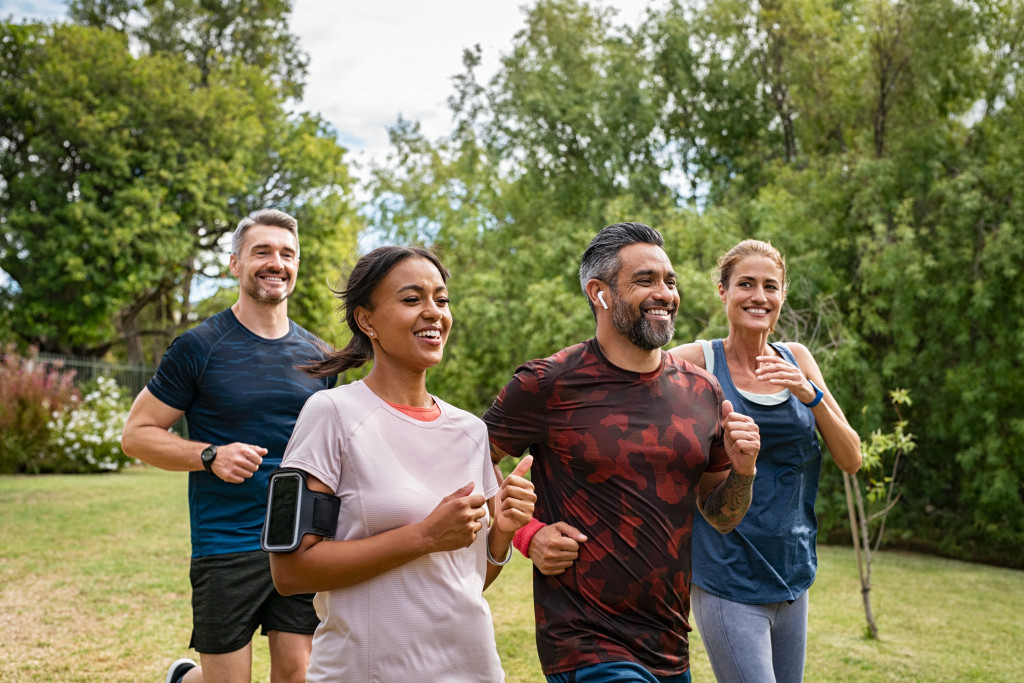- Choose activities you enjoy, such as stand-up paddle boarding or rock climbing.
- Incorporate low-impact exercises like yoga, jogging, walking, swimming, or biking.
- Participate in group activities like dancing classes, hiking clubs, and swimming.
- Incorporate mobility training to prevent injury and increase flexibility.
- Prioritize strength training for maintaining bone density and muscle mass.
As you enter your 40s, staying physically active is more important than ever. Whether it’s to prevent illness and disease, maintain a healthy weight, or reduce stress and anxiety — regular physical activity in your 40s helps to promote overall well-being. Here are five tips to stay physically active in your 40s.
1. Choose Activities You Enjoy
When it comes to physical activity, it’s essential to find activities that you genuinely enjoy doing. That way, you’re likelier to stick with them and make them part of your routine. Think outside the box—try something new, like stand-up paddle boarding or rock climbing. Or look into team sports like ultimate frisbee or tennis. Just make sure the activity is something you’ll look forward to doing.
2. Work Out with Low-Impact Exercises
Low-impact exercises can be a great way to get in shape as you enter your 40s. Low-impact activities such as walking, swimming, and biking are ideal choices since they don’t put too much stress on your joints while still helping you build muscle strength and endurance. Low-impact exercises can be done in several ways. You can work out at home with apps or DVDs, join a fitness class, or find a gym that offers low-impact workouts.
3. Participate in Group Activities
Group activities are a great way to stay motivated and engaged in your physical activity routine. Consider joining a running club or even going on regular hikes with friends. Group activities can also be more fun than working out alone.
Here are other group activities you can join:
Dancing classes
Dancing is an engaging way to stay active and have fun. At any age, energetic ballroom dancing classes can be a great way to socialize and learn new moves. Such classes can also help improve your coordination, balance, flexibility, posture, and overall fitness levels. Plus, you’ll enjoy music from different eras while learning to dance.
Hiking clubs

Hiking is one of the most popular outdoor activities; you get to explore the great outdoors and breathe in some fresh air while getting your daily dose of exercise. Joining a hiking club puts you in touch with other passionate hikers who can help each other with tips, advice, and good company.
Swimming
Swimming is a great way to exercise, cool off on hot summer days, and have fun. Joining a swimming club allows you to make new friends while improving your fitness level. Group swims are usually more enjoyable than hitting the pool alone, as there’s always someone around for motivation and encouragement.
Martial arts
Martial arts classes are a great way to stay physically active in your 40s, as they require both physical exertion and mental focus. All ages can benefit from the discipline, self-defense tactics and mental clarity that martial arts classes provide.
4. Incorporate Mobility Training
By your 40s, you may notice stiffness or a decreased range of motion. This is why it’s so important to incorporate mobility training into your regular exercise routine. Mobility training helps increase flexibility and range of motion. It also helps reduce the risk of injury by strengthening weak areas of the body and helping to improve posture.
There are many types of mobility exercises, including foam rolling, dynamic stretching and yoga. All these can help improve how you move and feel daily. So make sure to add some mobility training into your regular fitness routine.
5. Prioritize Strength Training

Strength training is invaluable for people in their 40s. Building muscle helps maintain a healthy weight while strengthening your bones and reducing the risk of osteoporosis. In addition, strength training can help you stay mobile and injury-free as you age.
Focus on the compound, multi-joint exercises such as squats, deadlifts, and presses. These exercises stimulate multiple muscle groups at once and promote the most efficient use of your energy during and after workouts. Including isolation exercises such as bicep curls, triceps extensions, and calf raises in your routine is also important. Isolation exercises help target specific muscles not as well stimulated with compound movements.
In Summary
Remember that staying active in your 40s is about finding activities you enjoy and slowly building strength and endurance. You don’t have to be an athlete—just set realistic goals for yourself and take it one day at a time! By following these tips, you’ll be well on your way to maintaining an active lifestyle.

